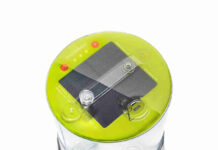
This week, SiGNa Chemistry Inc. unveiled its new hydrogen cartridges (Mobile-H2™), which provide energy to fuel cells designed to recharge cell phones, laptops and GPS units. The green power source is geared toward outdoor enthusiasts as well as residents of the Third World, where electricity in homes is considered a luxury.
SiGNa’s mobile-H2™ cartridge contains safe sodium silicide (NaSi); a powder that produces hydrogen (H2) on- demand from its reaction with any type of water, including salt water, packaged in a cartridge for use with fuel cells rated from 1 W to 3 kW.
Mobile- H2™ cartridges meet fuel cell requirements for load management with rapid startup and shutdown capabilities. Electronics can obtain consistent power output over the entire runtime with zero power degradation, as seen in batteries. The mobile-H2™ cartridges are configurable and can be set to operate at a range of pressures from one to 15 psi with a +/- 0.5 psi variability over its lifetime. Cartridges can also be easily exchanged to extend runtime without interrupting power.
Sodium silicide is a non- flammable, air- stable powder and reacts even with non- potable, non- distilled waters at room temperature to form H2 in a rapid, stable, and controllable reaction.
“SiGNa has created an inherently safe solution to produce electric power, resulting in an eco-friendly and cost-effective portable solution,” said Michael Lefenfeld, SiGNa’s CEO.
The spark for this groundbreaking technology came from the laboratory of James Dye, SiGNa’s co-founder and University Distinguished Professor of Chemistry Emeritus at MSU. His work with alkali metals led to a green process to harness the power of sodium silicide, which is the source for SiGNa’s new product.
“In our lab, we were able to produce alkali metal silicides, which basically are made from sodium and silicon, which, in turn, are produced from salt and sand,” Dye said. “By adding water to sodium silicide, we’re able to produce hydrogen, which creates energy for fuel cells. The byproduct, sodium silicate, is also green. It’s the same stuff found in toothpaste.”
SiGNa was able to build on Dye’s research and develop a power platform that produces low-pressure hydrogen gas on demand, convert it to electricity via a low-cost fuel cell and emit simple water vapor.
Dye, director of SiGNa’s scientific council, said that making the jump to research the company’s products was a small one.
“I’ve been working with alkali metals for 50 years,” he said. “My research was closely related to what SiGNa was looking for. So when they came to me with their idea, it was a relatively easy adaptation to make.”
Dye came to MSU in 1953 – two years before MSU was a university. Based on the products that can be linked to Dye’s research just in the last year, it’s clear that he is reaping the rewards of his six decades of scientific sowing.
Using a similar process, Dye was able to assist the creation of a fuel source to power electric bicycles.
The fuel cell, developed by SiGNa’s partners, ranges in size from 1 watt to 3 kilowatts and is capable of pushing a bicycle up to 25 mph for approximately 100 miles.
While the mainstream attention of his work is rewarding, it’s the untamed excitement of daily discovery and being able to share it with his students that fuel Dye’s desire to maintain a full-time research schedule.
“Instilling that excitement about chemistry in my undergraduate students and giving them a jump on their graduate research is my reward,” Dye said. “Everyone who has come through the lab and gone on to graduate school has had glowing reviews on how this experience helped their career.”



